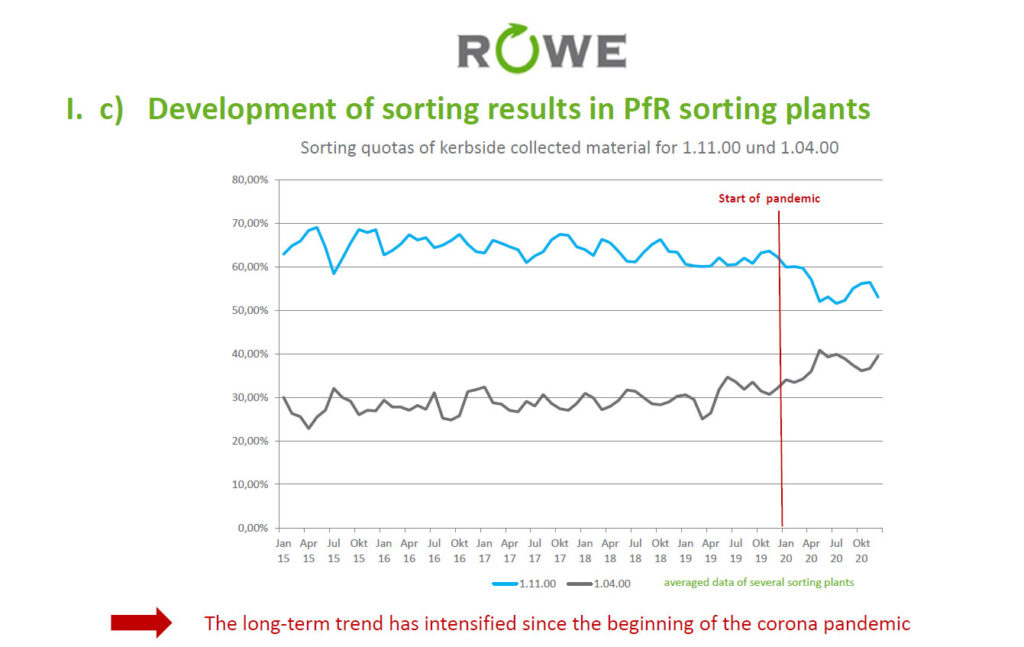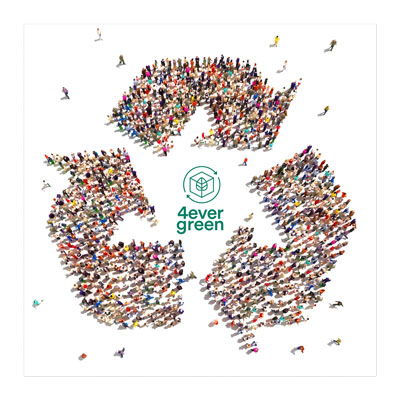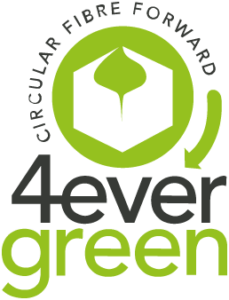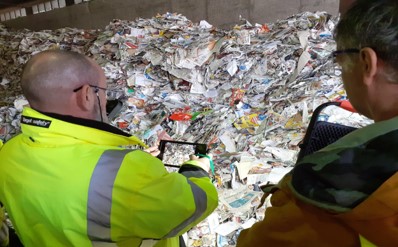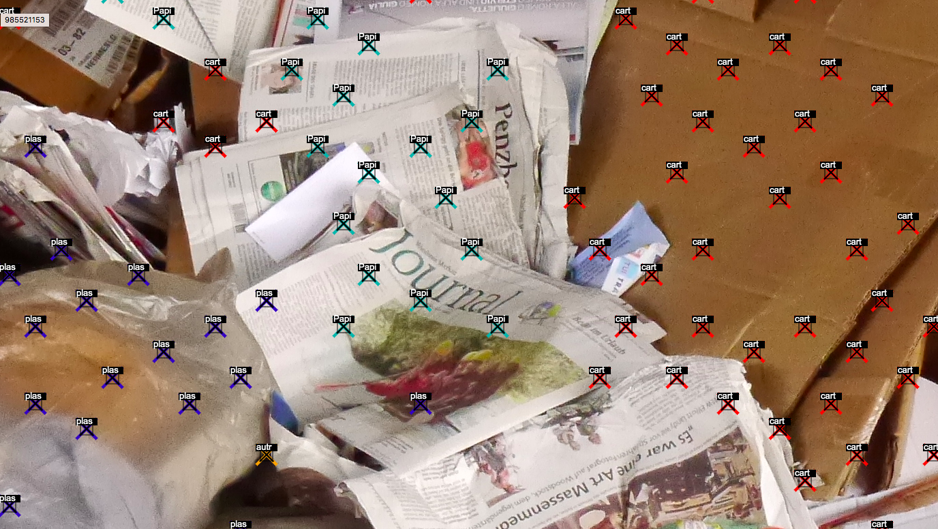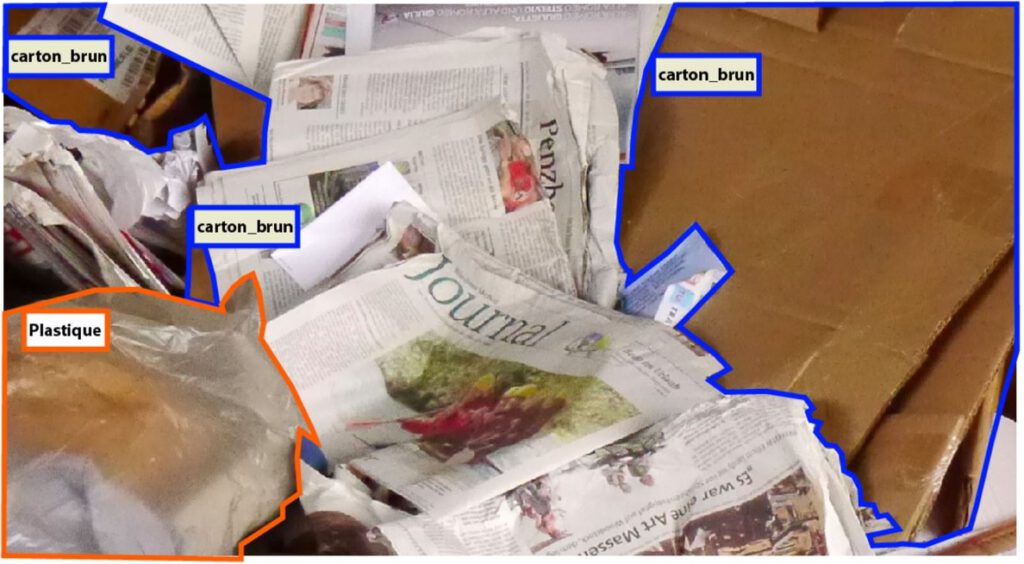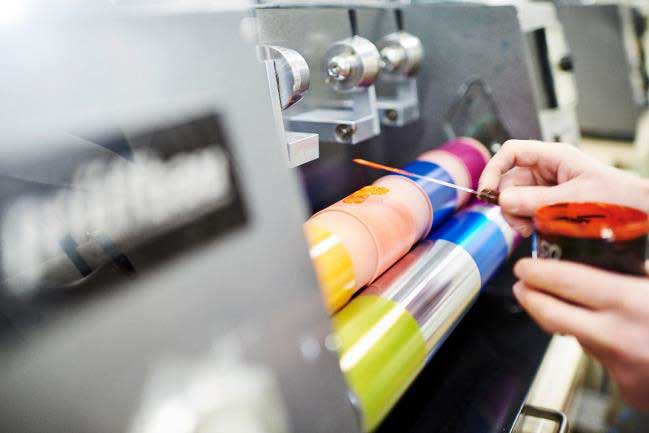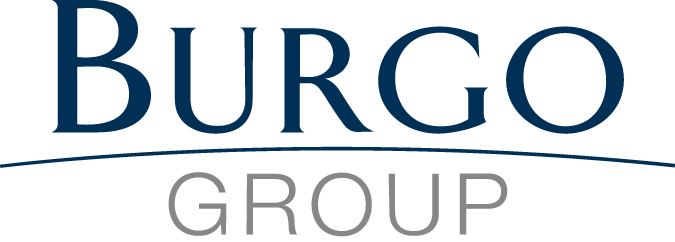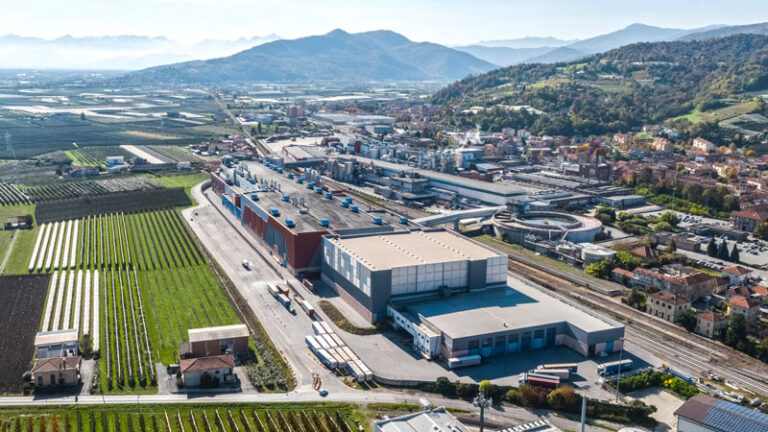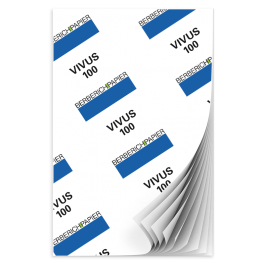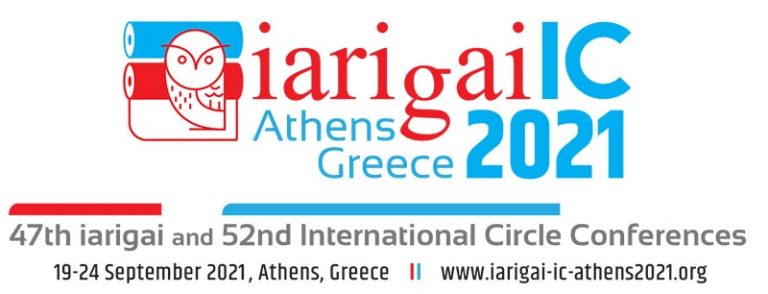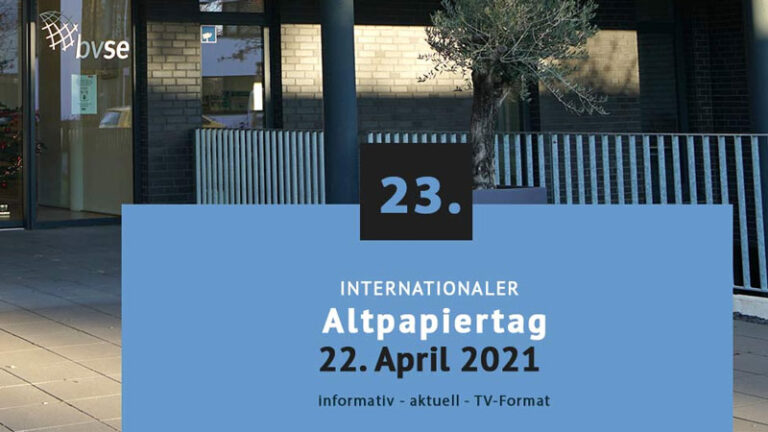INGEDE News Spring 2021 –
INGEDE Symposium with more participants ever!
- Calendar of events
- Online format brings more participants: INGEDE Symposium on March, 2nd, 2021 online!
- 4evergreen: A new alliance for fibre-based packaging
- Fotonower and Perlen examine recovered paper input
- Zeller+Gmelin: “UV ink series with excellent deinking properties”
- Burgo Group is first Gold Partner of INGEDE
- Austrian police prints on Lenzing paper
- Kriebstein mill to be improved by Schönfelder
- bvse Paper for Recycling Day on 22 April: Less paper collected
- iarigai September 19-24 in Athens
- Fresh fibre or recycled paper? What is more climate friendly?
- SUBSCRIBE HERE to our newsletter!
INGEDE Symposium 2021 online on March 2nd
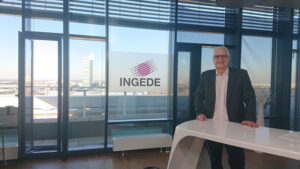 More participants than in previous years thanks to the online format: In a makeshift studio, only the moderator stood in front of the camera, all other speakers as well as the participants were connected via internet.
More participants than in previous years thanks to the online format: In a makeshift studio, only the moderator stood in front of the camera, all other speakers as well as the participants were connected via internet.
INGEDE Symposium 2021: „The circular economy of paper must be actively strengthened“
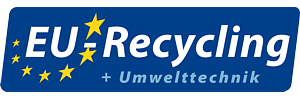 A report on the symposium by Marc Szombathy, published in the journal EU Recycling (originally in German, translated with assiscance of DeepL)
A report on the symposium by Marc Szombathy, published in the journal EU Recycling (originally in German, translated with assiscance of DeepL)
The INGEDE Symposium 2021 on 2 March in digital format again covered all aspects of paper recycling: from recyclability to waste paper collection and the deinking process.
The challenges that new printing inks and a variety of different adhesive applications pose for recycling were discussed. In view of increasing quantities of white packaging, the question for the deinkers continues to be: How can the paper industry benefit from the new packaging legislation? The focus was also on processes for better collection and sorting as well as identification of foreign materials in the recovered paper stream.
Moderated by Axel Fischer (INGEDE), the symposium first looked at sustainability in the production of books and the new EU Ecolabel for printed products. Speakers here were Wolfram Dietz (bifa Umweltinstitut), Andreas Steenbock (Steinbeis Papier), Antonia Pott (RAL gGmbH), and Malgorzata Kowalska (EU Commission).
Martin Drews (Verband Deutscher Papierfabriken, German Association of the Paper Industry, VDP) then reported that there is sufficient paper for recycling available in Europe. The VDP estimates that last year there was a clear surplus of more than four million tonnes in Europe with a recovered paper volume of about 58.7 million tonnes and a consumption of 54.5 million tonnes. However, availability varies from country to country in Europe, and the qualities of the available recovered paper also vary.
The share of recovered paper as a raw material in paper production is expected to grow worldwide; thus consumption will increase. This may also have an impact on availability in Europe – with the effect that the current surplus of paper for recycling in the European market (including Turkey) will decline in the coming years. To counteract this, he said, the circular economy of paper must be actively strengthened.
Drews pleaded for the development of a complete and high-quality municipal waste paper collection system throughout Europe. The municipalities should help and support the long-term securing of raw materials and the achievement of ambitious recycling quotas. It is important to improve collection at the source. The sorters and suppliers should provide the recovered paper to the companies using recovered paper in the right quality so that it is also available for paper production – in other words, increase the sorting depth. Imports of raw materials to Germany would have to be secured and facilitated with regard to the supply of raw materials.
In this context, Martin Drews spoke out in favour of strengthening the internal market and expressed his conviction that together with all stakeholders in the recovered paper value chain, its availability in Europe can also be secured in the future.
Return to the status quo ante corona?
The presentation by Marc Ehrlich (Vipa) focused on the availability of graphic recovered paper and its share in the collection. Over the past six years, the composition of waste paper collected from households has changed noticeably: Fewer and fewer brochures, magazines or advertising journals. Print advertising in Germany has declined by 12.6 per cent. Less and less graphic paper is being produced, which is then missing from waste paper recycling.
The trend is clearly towards white office and packaging papers, which is also due to the pandemic – caused by home offices. Achim Wiese (ROWE Gesellschaft für Rohstoffhandel, Wertstoffrecycling Entsorgung mbH) also observes an increase in the proportion of foreign matter in the waste paper quantities from household collection due to misthrows and poor sorting performance by the reprocessors: “There is more and more waste in the waste paper that arrives at the paper mills.” The expert does not believe “that the mix of roadside collected material will return to the status quo ante corona.”
Trend towards digitalisation accelerates
According to VDP figures, in 2020 the German paper industry’s recovered paper input ratio was 79 per cent, one per cent more than the year before. In total, the paper industry produced around 21.4 million tonnes of paper, cardboard and paperboard in 2020. The turnover of the industry as a whole fell by 11.6 percent to 12.7 billion euros. The production of packaging papers – the largest group of grades in Germany – increased by 2.6 percent to 12.4 million tonnes in the crisis year 2020. The reason for the positive development was the increased demand for packaging for food and online trade during the Corona pandemic. Sanitary papers also recorded a production growth of two per cent. The hoarding of toilet paper had presented manufacturers with special challenges in production and logistics. In 2020, a total of 1.5 million tonnes of tissue papers were produced, about half of which was toilet paper.
The production of graphic papers declined significantly in 2020. Here, production fell by 15.1 per cent to six million tonnes. On the one hand, the Corona pandemic has further accelerated the trend towards digitalisation; on the other hand, there were one-off effects caused by the lockdown, especially in the second quarter of 2020, for example in the postponement of advertising measures and the closure of sales outlets. This affects the entire print value chain. The production of paper and board for technical and special purposes remained almost unchanged at minus 0.2 percent; this includes, for example, decorative papers for the furniture industry. Here production was around 1.4 million tonnes.
Collect graphic paper and packaging separately?
It was also discussed whether graphic paper and packaging can and should be collected separately at source. Achim Wiese sees this as unfeasible from a cost perspective: “If we only collect packaging, then you have an enormous volume in the collection vehicle. But the weight is very low. And that is also very questionable from the carbon footprint. We need to think about whether single-stream recycling, as practised in the US and other countries, can lead to an increase in quality – by sorting better then.”
A further deepening and expansion of the separation system would also not meet with acceptance among the population. And it is questionable whether separate collection would still produce sufficient quantities of graphic paper for deinking. Improving the quality of waste paper sorting would also be cost-intensive. Are the paper mills prepared to pay higher prices for better sorted goods? Johannes Jacoby (Tomra Sorting Recycling) and Victor Reutenauer (Fotonower) presented how sorting processes can be optimised through digitalisation and artificial intelligence. The French company Fotonower, for example, has developed a camera-based solution for quality recognition during incoming goods inspection in sorting companies.
Philipp Stolper (Fogra) reviewed the current status of research into mineral oil-free printing inks. Since 2016, the Fogra Research Institute for Media Technologies has been working in a funded project on the market launch of mineral oil-free coldset inks. The aim of the research project was to develop two ink series to such an extent that their permanent use in print shops is possible. This was to be proven by three-month practical trials. In addition to the applicability, one focus was on the deinkability of the products as well as the analysis of the mineral oil content according to the BfR method. The newly developed inks were used in the printing press of the Frankfurt Societäts-Druckerei. Thus the functionality was only tested on one type of coldset press.
First printing trials on the coldset press started in 2018; since then, deinkability has been monitored by applying INGEDE Method 11 to print samples from the coldset press. In 2020, the inks were ready to be used in a long-term trial for three months. During this time, deinkability was regularly checked. In addition, identical print samples could be produced with the conventional inks of an ink manufacturer. Two types of paper were used for these deinkability tests: one with 50 per cent DIP and one consisting of 100 per cent DIP. This made it possible to compare the deinking properties of the mineral oil-free inks with those of the conventional, mineral oil-based inks. The results show that the deinkability of mineral oil-free coldset inks has not yet been fully solved and that further efforts must be made to achieve this goal. The detailed evaluation of the deinking tests was presented in this paper by two different ink manufacturers.
France is the only European country that has defined a legal ban on mineral oils on paper and packaging. As the responsible producer organisation for packaging and graphic papers in France, Citeo participated in a global action plan on mineral oil issues in 2018, introduced a malus system for packaging (2020) and graphic papers (2021) and did some R&D work to help develop some low mineral oil alternatives. The organisation was represented by Jean-François Robert.
The lecture by Beatrix Genest (SID) dealt with the deinkability of UV-curing printing inks (IGF 20476). A project investigated the deinkability of UV prints and the fate of substances of health concern. The aim was to objectively assess the deinkability of UV printed products depending on the printing conditions, taking into account the ink, paper quality and ink curing. In the end, the deinking behaviour of UV inks could be compared with conventional sheetfed offset prints with and without UV coating.
In phase one UV commercial prints were investigated. Of 38 print jobs provided by different printers, 28 were tested: 17 passed and eleven failed the deinkability test. The reason for failing was always dirt specks. When looking at the influencing factors, there was no effect of the paper quality. There were problems with some samples that were cured with a mercury lamp and with several samples that were treated with an iron-doped mercury lamp. All samples cured with UV-LEDs showed good results. In general, there was no correlation between curing level and deinkability score.
To find out more about the correlation between printing conditions and deinkability, pilot tests were carried out on a CD 74 sheetfed offset press. Mercury lamps, iron-doped mercury lamps and UV LEDs for UV curing were used for these tests. Glossy and matt coated as well as uncoated substrates were printed with 16 different UV inks. The UV dosage, the pressure and the composition of the fount solution were varied for all 180 variants. Again, no significant correlation was found between UV ink curing and deinkability. Ultimately, the ink formulation and the ink application of the printed samples proved to be the main factors influencing deinkability. This means that for a general assessment of the deinkability of UV inks it is important to create a test form with defined ink application and to determine at least one paper quality, Beatrix Genest concluded.
The rest of the programme included a presentation of the 4evergreen alliance by Susanne Haase, which has already won 60 members across the entire value chain of fibre-based packaging for its goals. Christian Aumüller (Aumüller Druck) and Volker Hotop (Frankfurter Societäts-Druckerei) reported from printing practice. Ulrich Leberle (CEPI) informed about the development of a European recyclability method for packaging and Laetitia Reynaud (Intergraf) about trends in the European market for printed products. Finally, the presentation by Hermann Onusseit (IVK) took up the banner for adhesive applications that would not necessarily make paper recycling more difficult.
 (Erschienen im EU-Recycling Magazin 04/2021, Seite 40)
(Erschienen im EU-Recycling Magazin 04/2021, Seite 40)
INGEDE becomes member of the advisory board
of the 4evergreen Alliance
INGEDE is now member of the newly formed Industry Association Advisory Group of the 4evergreen (4EG) Alliance. The group will meet by video conference on a monthly basis and learn about the progress in 4EG.
As a cross-industry alliance, 4evergreen fosters synergies among companies promoting low-carbon and circular fibre-based packaging. By bringing together the entire value chain, 4evergreen enables cooperation with a comprehensive outlook on fibre-based packaging’s life cycle.
All 4evergreen workstreams are driving standards and innovative solutions to improve the circularity of fibre-based packaging:
• Workstream 1 is creating a protocol to assess recyclability
• Workstream 2 is developing “circularity by design” guidelines
• Workstream 3 is devising guidelines for improved collection and sorting
• Workstream 4 accelerates the development of new technologies and processes
With smartphone and artificial intelligence:
Fotonower and Perlen examine recovered paper input
Last year, the Swiss paper mill Perlen Papier commissioned the young French company Fotonower to investigate the feasibility of implementing a semi-automated incoming inspection (QUALIPAPIA) as part of a study: By evaluating digital images, the waste paper quality was to be analysed in comparison with the Perlen in-house method and gravimetric examination (INGEDE Method 14). Victor Reutenauer from Fotonower presented the results at the INGEDE symposium in early March.
For this purpose, Perlen provided 60 data sets on 10 digital images of common waste paper shipments. These images were created using a smartphone and uploaded to a Fotonower web archive.
For the same waste paper deliveries, Perlen carried out a visual quality control using the Perlen in-house method (visual inspection of the delivery, indication of unwanted materials and non-paper components as sum parameters as a percentage of the delivery). Furthermore, these deliveries were also evaluated gravimetrically. This data was also made available to Fotonower.
AI compared to manual allocation of images
Fotonower analysed the data sets automatically with the help of artificial intelligence, and then also by manually assigning individual image sections. The AI solution is self-learning and used images from 2019 and 2020 from other paper mills. This makes it possible to train and test the evaluation with independent data.
Lighting turned out to be an important factor: sufficient light is important to recognise the components well. In future, an upstream check of the image material should immediately indicate whether the lighting is sufficient or not.
| Gravimetric analysis INGEDE Method 14 | Visual inspection Perlen in-house method | Qualipapia manually | Qualipapia automatically | |
| Gravimetric analysis INGEDE Method 14 | 100 % | 91 % | 83 % | 57 % |
| Visual inspection Perlen in-house method | 100 % | 79 % | 53 % | |
| Qualipapia manually | 100 % | 70 % | ||
| Qualipapia automatically | 100 % |
The results show that the visual assessment in Perlen has a 91 % correlation with the gravimetric observation. The manually evaluated Qualipapia images still show a correlation of 83 % to the gravimetric and 79 % to the visual assessment. This clearly shows that it is possible to filter out sufficiently good data from the images. The automated solution unfortunately only achieves a correlation of a good 50 %, here Perlen is in further discussions with Fotonower on how the results can be improved.
However, an essential aspect of this image-based approach is that this represents an objective evaluation and thus enables a more transparent discussion between supplier and user.
Dennis Voß/Axel Fischer
Zeller+Gmelin: "UV ink series
with excellent deinking properties"
The Swabian ink manufacturer Zeller+Gmelin is expanding its range of deinkable offset inks designed to further improve the recyclability of UV-printed paper and board products. A company press release says Zeller+Gmelin has now revised its UV offset ink series UVALUX U40 for commercial printing and UVALUX FCM U41 for printing food packaging.Samples of these were produced on coated and uncoated paper and submitted to INGEDE for deinkability testing. These were examined according to INGEDE Method 11 and rated as “good deinkability” according to the standardised assessment procedure of the European Recovered Paper Council, the “Assessment of Printed Product Recyclability Deinkability Score” (EPRC 2017).
For this, Michael Handl as Group Leader (R&D) for Commercials & Packaging and Nadine Hofmann as the responsible Product Manager had visited the INGEDE laboratory in Bietigheim-Bissingen. Beforehand, the researchers at Zeller+Gmelin worked intensively on the implementation of a test method in their own laboratories and were thus able to quickly carry out a preliminary assessment of deinkability. INGEDE welcomes the interest in the topic of deinkability and the corresponding recycling-friendly further development.
Furthermore, the new UVALUX LED U540 Commercial, an LED UV ink series for LED sheet-fed and web offset printing, is also deinkable. UV inks offer advantages in the printing process due to their fast drying. However, they are often difficult to remove when recycling the paper. The new inks are intended to contribute to making packaging today as resource-efficient as possible as well, in order to support “the recycling target defined by the EU for paper and board packaging of increasing the recycling rate from 60 % to 85 % by 2030”, according to the press release.
Source: Press release Zeller+Gmelin/fis
Burgo Group is first Gold Partner of INGEDE
 With the Burgo Group, INGEDE has gained its first Gold Partner – and at the same time the first paper company as a partner. Burgo used to be an active member of INGEDE when the company was still deinking itself in the Mantova and Marzabotto mills. In the meantime, purchased deinked pulp is used for graphic papers.
With the Burgo Group, INGEDE has gained its first Gold Partner – and at the same time the first paper company as a partner. Burgo used to be an active member of INGEDE when the company was still deinking itself in the Mantova and Marzabotto mills. In the meantime, purchased deinked pulp is used for graphic papers.
With sales of 1.99 million tonnes of paper in 2019, Burgo Group is a leading partner for companies in the graphic arts, printing, publishing and packaging sectors. The production and distribution of graphic papers, containerboard and speciality papers (e.g. paper for food packaging) are the main activities of the group, which is also active in the production and distribution of fibre raw materials and energy.
The Burgo Group includes 12 mills, 11 in Italy and one in Belgium, operates 15 paper machines and two chemical pulp production lines as well as one mechanical pulp production line for internal use.
The Burgo Group’s history began on the threshold of the 19th and 20th centuries, when the young engineer Luigi Burgo built a hydroelectric power plant in Verzuolo, Piedmont (1899) and subsequently founded his first paper mill (1905). Since then, the company has grown continuously. In the 1980s, a new and profitable partnership began with the contact between the Burgo and Marchi companies.
INGEDE is pleased to be able to cooperate with the Burgo Group again more intensively in the field of paper recycling!
Under the historic Burgo brand – recognisable by the four b’s – the group’s catalogue of graphic papers now includes many advanced, high-quality products, in addition to the rich range of woodfree papers for high-quality printing and the range of coated papers for publishing.
These include recycled papers, ideal for particularly sustainable publishing projects, digital inkjet and laser printing papers, designed for marketing projects, for transpromotional communication and for document printing, including high-quality papers for short runs, and finally, of course, lightweight, very thin and highly opaque papers, for pharmaceutical and cosmetic brochures or for high-pagination books. The range is complemented by reliable, environmentally friendly office papers.
Das Burgo-Werk Verzuolo im italienischen Piemont
Photo: www.burgo.com
Print is alive – also for the Austrian police: on Lenzing paper
“INSIDE“, the magazine of the Provincial Police Directorate of Upper Austria and Police Sport ÖPOLSV, is becoming more environmentally friendly: Aumayer Druck in Munderfing will in future print the magazine on “Vivus 100”, an uncoated recycled paper from Lenzing Papier. Other provincial police directorates will follow this example and replace the previously used coated virgin fibre paper with locally produced recycled paper. With the corresponding deinkable printing inks, the magazines thus also qualify for the Austrian eco-label for printed products.
Schönfelder investing in Kriebstein mill
The Schönfelder Group, Annaberg, wants to invest at the site of Kübler & Niethammer Papierfabrik Kriebstein GmbH (K&N Paper). The company has put together an investment package for this purpose.
The investment aims to expand the recovered paper warehouse and modernise production facilities, the company tells EUWID. The work is to begin in the summer, and the contracts have been awarded to the relevant companies. The individual measures require the interruption of production in Kriebstein by more than a week. The plan is to have all work completed by late summer.
Schönfelder had taken over the bankrupt Kübler & Niethammer Papierfabrik Kriebstein last year.
Subscribers can read the full articcle in EUWID Pulp and Paper.
Photo: k-n-paper.de/
iarigai September 19-24 in Athens
The Hellenic Graphic communication communities – media, printing and packaging – welcome iarigai and IC to Athens, Greece for their annual scientific conferences, which will take place from 19 to 24 September 2021. iarigai – the International Association of Research Organisations for the Information, Media and Graphic Arts Industries – and IC, the International Association of Educational Institutes for Graphic Media Technology and Management are among the most prominent research and educational organisations for the fields of printing, media and packaging worldwide.
The organisers invite all those working in the fields of graphic communication – media, printing and packaging to attend the conferences. Researchers and entrepreneurs, employees and companies, students and educators, business and production companies are invited to register, either as speakers of scientific and technical papers or as participants in both conferences.
INGEDE will participate with a contribution on sustainable printed products.
Read more: iarigai-ic-athens2021.org
International bvse Paper for Recycling Day on 22 April:
"Recovered paper is the paper industry's most important raw material"
What will the demand for recovered paper look like after the pandemic? Where do Germany and Europe stand in the global competition for recovered paper as a raw material and what does this mean for our operations? What practical problems will the new barrier packaging bring for the sorting companies? Will graphic papers still be available for the paper industry in the future? What about the future of deinking? These were the topics at the bvse’s recovered paper day.
Werner Steingaß, bvse Vice President and Chairman of the Paper Recycling Association, pointed out in his contribution that the worldwide use of recovered paper has been increasing for years. More than 250 million tonnes of recovered paper are processed annually by the paper industry. Steingaß: “This development shows that recovered paper is the most important raw material in the paper industry.”
Nevertheless, the last few years have not been easy for the recovered paper companies, as the bvse vice president explained. For example, the industry had to adjust to the structural changes in the Asian markets. This was a great challenge, especially for the exporting companies. “Currently we are experiencing the effects of the Corona pandemic. We have noticed that the amount of paper collected for recycling has dropped significantly. This has led to a drastic drop in the supply of recovered paper and to price movements that we have never seen to this extent before,” said Werner Steingaß.
Steingaß said it was important to improve paper collection structures worldwide. Paper for recycling must be collected separately from other materials, he said, because this is the basis for the paper recycling industry to be able to adequately supply the paper industry worldwide with high-quality recovered paper. The Chairman of the bvse Paper Recycling Association concluded by pointing out that not only the world’s population, but also the demand for packaging and thus for recovered paper would increase steadily.
Read more: altpapiertag2021.bvse.de
Fresh fibre or recycled paper?
Facts regarding a press release by Iggesund Papier
Facts (and a few thoughts) on the current irritation caused by a comparison of the climate friendliness of recycled paper and virgin fibre
1) As the headline says, the current discussion was triggered by a press release from Iggesund, a Scandinavian manufacturer of paper and packaging made from fresh fibre. The labelling as a marketing measure by means of a corresponding source reference was done, for example, albeit discreetly, in the German reproduction on the Global Print Monitor page, but was inadvertently omitted, for example, on print.de, the “Central Organ” of German printers, and has caused corresponding irritation and uncertainty.
2) The press release is based on a study by scientists at Yale University together with University College London, which was published in Nature Sustainability in October 2020. The paper was submitted on 24 July 2019, only a few months after Holmen published a study that came to similar conclusions. This “Holmen study” was prepared by Swedish researchers (IVL Swedish Environmental Research Institute) and was widely criticised because, for example, neither water nor wastewater nor chemical consumption were taken into account. Even if the chronological connection seems striking, Iggesund and Holmen have nothing to do with the “Yale Study”, as Iggesund states. Iggesund has picked up on this as an “interesting perspective”, but is not involved in its development and has not supported it financially.
3) Fundamental problem #1: Every study on the climate impact of a product or process is different. The results vary widely from study to study and depend in particular on the boundary conditions assumed. This depends on the extent to which, for example, preliminary products or transports are included in the calculation. This leads to the fundamental problem #2: Values on the climate impact of a product or process, here expressed in kilograms of carbon dioxide per tonne of paper, from different studies with different assumptions are not seriously comparable.
4) Comparing recycled paper and virgin fibre in this way is not appropriate. To see a competition here or to build one up for marketing reasons is: simply marketing, unfortunately. Fresh fibre and recycled paper have their place side by side. Without virgin fibre there would be no recycling, and without recycling there would not be enough virgin fibre to meet the demand, especially for short-lived print products and packaging. The circular economy is a declared environmental policy goal and consensus. Not using recovered paper as a resource would be anachronistic, a complete waste. The fact that in this country the production of paper from recovered paper requires much less energy and much less water than virgin fibre, and also conserves resources, is beyond question, is the legitimisation for Blue Angels and other eco-labels – and may be the background to the marketing woes of Scandinavian virgin fibre producers who are trying to save market share in the face of an overall decline in demand for paper, also due to the pandemic.
5) In the press release, the Yale study is first summarised, then useful statements are highlighted in the sense of the publisher. Even though many other statements are made in the study that would also allow other statements. And one can also disagree with the methodology or the assumptions made and the boundary conditions, but more on that later. Then, however, own figures come into play via a quotation, which have nothing to do with the study itself. But: The fleeting reader is left with the impression that these also originate from the study.
6) Apples, pears, lingonberries: The press release states that “Iggesund produces 33 kg per tonne of direct CO2 emissions in the production of Invercote board”, compared to a “leading European recycled fibre producer (who) emits 294 kg of CO2 per tonne according to its own environmental report. Emissions are even higher for some American paper recyclers, which release more than 1,000 kg per tonne.” The assumptions under which these figures were calculated are missing – and of course the values published by individual companies or institutes scatter widely, depending on who is doing the calculations and which model is used.
“Direct” emissions means only during production, without taking into account preliminary products and transport. In Scandinavia, therefore, with electricity from hydroelectric power and nuclear energy, set at zero CO2 emissions. If I, as a customer, want to use this product and balance it for my company in Frankfurt or Stuttgart, I have to add a considerable rucksack for almost 2,000 kilometres of transport: with 111 g CO2 equivalents per kilometre (source: Federal Environment Agency), this is already 222 kg/t, which drastically relativises the alleged environmental advantage of Scandinavian fresh fibre compared to recycling in Germany, which, however, is again burdened by a different electricity mix in the calculation. Assuming average values here does not do justice to a company that generates its electricity in an environmentally friendly way with combined heat and power using substitute fuel, which would be equivalent to Scandinavian electricity in the life cycle assessment. The ping-pong game could be continued at will, each assumption varied, one or the other parameter also taken into account or neglected according to the desired result.
7) The Yale study models a total of 27 different scenarios. However, the strikingly quoted core statement is only derived from a scenario that assumes a radical change in material flows (maximum recycling rate and reduced fresh fibre production) while maintaining current energy use and landfilling. But why shouldn’t the energy mix also change in a scenario calculated up to 2050? This is even mentioned in the study as a way forward? The study assumes that the production of virgin fibres gains most of its energy from the combustion of so-called black liquor. This is considered biogenic waste and thus climate-neutral. Recycled paper production, on the other hand, relies mainly on climate-damaging fossil fuels. But what about virgin fibre, for the production of which black liquor is not used, and recyclers who do not order the statistical electricity mix, see ping-pong, above? Parts of the Yale study that are not highlighted even outline conditions under which the paper industry as a whole can be counted on to net GHG reductions by 2050 (Figure 4 of the study). It’s all a question of making assumptions, of perspective.
8) The tree: Who thinks of me? Now it gets even more (environmentally) political. Paper is not harmful to the environment because it is made from renewable raw materials. The forest cover in Europe is increasing. All true. Above all: (printed) paper has proven in many studies to be more sustainable under many conditions than digital information via the internet, from the cloud, which is virtually a CO2 cloud considering the power-guzzling server plantations that process, store, and provide information around the clock. It therefore makes little sense to do away with paper in general just to protect trees. But the worldwide pressure on the forest can of course be reduced by recycling paper. And anyone who then emphasises paper made from virgin fibres over recycled paper in terms of climate protection has to put up with the question: What about the trees? As an infinitely available raw material, should they not be included in the balance sheet with “zero”? In a detailed statement, Robin Wood, for example, points out the ecological problems of intensive forest use, including the qualitative change and damage caused by clear-cutting, methane release and subsequent timber plantations – even if the number of trees remains the same for the statistics. Even more fundamental is the debate about the burning of wood, which is assumed to be climate-neutral, “when studies show that more carbon dioxide is emitted per megawatt hour in the process than in the burning of coal?”
9) After all, ecology is more than just carbon dioxide. Ecology is also water consumption, sewage pollution, transport, land use, diversity. Fresh fibre is not necessary everywhere – sometimes because of physical or optical properties. But more often than you think, the more environmentally friendly recycled paper can be used. Many studies that examine the process holistically have shown this. That is why the circular economy is a European programme. Where else would the waste paper go? And where would all the wood come from if we recycled less? Already there is no more “waste wood”, British power plants burn wood pellets from the USA, a deforested nature park in Estonia questions the climate friendliness of wood combustion. Here, too, the perception is gaining ground: Using wood so intensively is precisely not climate neutral.
Conclusion: If you use recycled paper correctly, you reduce the burden on the environment. And those who use paper made from virgin fibre in the right place do not harm the environment either. Only those who play the two off against each other for marketing reasons damage the climate.
Axel Fischer (thanks to many who are more competent in this field)
Pictures: © Axel Fischer
This compilation has also been published as an interview (in German) on print.de, the web portal of Deutscher Drucker magazine:
click here
SUBSCRIBE HERE to our newsletter!

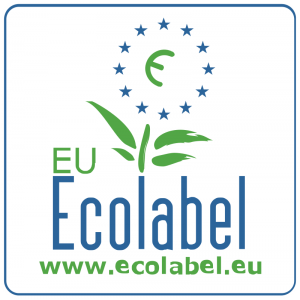
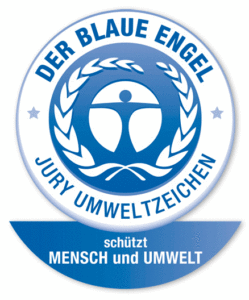 Blue Angel and EU Ecolabel: Antonia Pott (RAL gGmbH) and Malgorzata Kowalska (EU Commission) presented the two most important European ecolabels for paper and printed products.
Blue Angel and EU Ecolabel: Antonia Pott (RAL gGmbH) and Malgorzata Kowalska (EU Commission) presented the two most important European ecolabels for paper and printed products.